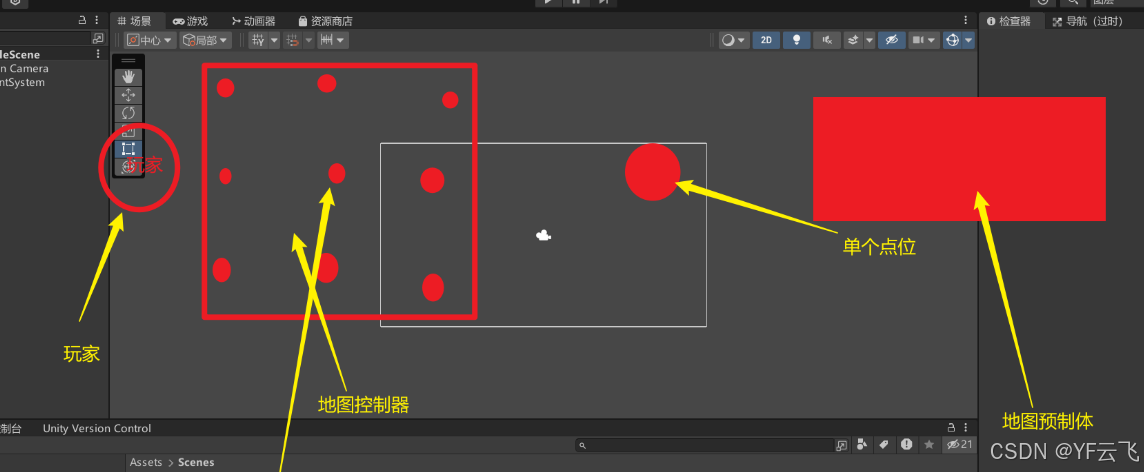目录

详细实现步骤
1. 场景基础设置
在Unity中创建一个新场景,按以下步骤初始化:
- 添加主摄像机(Main Camera),调整至合适的视角
- 创建玩家对象(Player),添加必要的组件:
- 角色控制器(Character Controller)
- 刚体(Rigidbody)
- 碰撞体(Collider)
- 玩家控制脚本
- 创建空游戏对象命名为"MapGenerator",用于挂载地图生成脚本
2. TileMap配置
创建Tilemap游戏对象:
- 右键Hierarchy面板 → 2D Object → Tilemap
- 添加Tilemap Renderer和Tilemap Collider组件
准备地形图块资源:
- 创建或导入多种地形图块(如:草地、森林、沙漠、水域等)
- 每种地形应包含:
- 基础图块
- 过渡边缘图块(用于平滑连接不同地形)
- 特殊装饰图块(如树木、岩石等)
配置Tile Palette:
- 创建多个Tile Palette面板,按地形类型分类
- 将图块资源拖入对应面板
3. 地图生成脚本详解
TileMapGenerator脚本的核心功能分解:
初始化参数
[Header("基本设置")]
public Tilemap tilemap; // 引用场景中的Tilemap组件
public Transform player; // 玩家对象引用
public int viewDistance = 5; // 玩家视野范围(区块单位)
[Header("地形设置")]
public TileBase[] grassTiles;
public TileBase[] forestTiles;
public TileBase[] desertTiles;
public TileBase[] waterTiles;
public TileBase[] mountainTiles;
[Header("生成规则")]
[Range(0, 1)] public float waterFrequency = 0.1f;
[Range(0, 1)] public float mountainFrequency = 0.2f;
public int minSameTerrainSize = 3;
public int maxSameTerrainSize = 7;
区块生成算法
采用分块生成策略,将地图划分为多个区块(Chunk):
- 区块坐标系统
private Dictionary<Vector2Int, TerrainType> generatedChunks = new Dictionary<Vector2Int, TerrainType>();
private Vector2Int currentPlayerChunk;
void Update()
{
// 计算玩家当前所在区块
Vector2Int playerChunk = new Vector2Int(
Mathf.FloorToInt(player.position.x / chunkSize),
Mathf.FloorToInt(player.position.y / chunkSize)
);
// 如果玩家移动到新区块,生成周围区块
if(playerChunk != currentPlayerChunk)
{
currentPlayerChunk = playerChunk;
GenerateSurroundingChunks(playerChunk);
}
}
- 地形生成规则
TerrainType DetermineTerrainType(Vector2Int chunkCoord)
{
// 使用柏林噪声生成自然过渡
float noiseValue = Mathf.PerlinNoise(
chunkCoord.x * 0.1f,
chunkCoord.y * 0.1f
);
if(noiseValue < waterFrequency) return TerrainType.Water;
if(noiseValue < waterFrequency + mountainFrequency) return TerrainType.Mountain;
// 其余情况根据位置决定基础地形
return (chunkCoord.x + chunkCoord.y) % 2 == 0 ?
TerrainType.Grass : TerrainType.Forest;
}
- 区块生成方法
void GenerateChunk(Vector2Int chunkCoord)
{
TerrainType type = DetermineTerrainType(chunkCoord);
generatedChunks[chunkCoord] = type;
// 计算区块边界
int startX = chunkCoord.x * chunkSize;
int startY = chunkCoord.y * chunkSize;
// 生成地形
for(int x = startX; x < startX + chunkSize; x++)
{
for(int y = startY; y < startY + chunkSize; y++)
{
TileBase tile = GetTileForPosition(x, y, type);
tilemap.SetTile(new Vector3Int(x, y, 0), tile);
}
}
// 生成装饰物
GenerateDecorations(chunkCoord, type);
}
4. 性能优化策略
- 对象池管理
// 区块对象池
private Queue<GameObject> chunkPool = new Queue<GameObject>();
// 获取区块方法
GameObject GetChunkFromPool()
{
if(chunkPool.Count > 0)
{
GameObject chunk = chunkPool.Dequeue();
chunk.SetActive(true);
return chunk;
}
return Instantiate(chunkPrefab);
}
// 回收区块方法
void ReturnChunkToPool(GameObject chunk)
{
chunk.SetActive(false);
chunkPool.Enqueue(chunk);
}
- 异步加载
IEnumerator LoadChunksAsync(Vector2Int centerChunk)
{
// 计算需要加载的区块范围
var chunksToLoad = CalculateChunksToLoad(centerChunk);
foreach(var chunkCoord in chunksToLoad)
{
if(!generatedChunks.ContainsKey(chunkCoord))
{
StartCoroutine(GenerateChunkAsync(chunkCoord));
yield return null; // 每帧生成一个区块
}
}
}
IEnumerator GenerateChunkAsync(Vector2Int chunkCoord)
{
// 异步生成区块内容...
yield return null;
}
5. 地图元素丰富化
- 环境装饰生成
void GenerateDecorations(Vector2Int chunkCoord, TerrainType type)
{
int decorationCount = Random.Range(5, 15);
for(int i = 0; i < decorationCount; i++)
{
Vector3 pos = new Vector3(
chunkCoord.x * chunkSize + Random.Range(0, chunkSize),
chunkCoord.y * chunkSize + Random.Range(0, chunkSize),
0
);
GameObject decoration = null;
switch(type)
{
case TerrainType.Grass:
decoration = Instantiate(grassDecorations[Random.Range(0, grassDecorations.Length)]);
break;
case TerrainType.Forest:
decoration = Instantiate(forestDecorations[Random.Range(0, forestDecorations.Length)]);
break;
// 其他地形处理...
}
if(decoration != null)
{
decoration.transform.position = pos;
decoration.transform.SetParent(decorationsParent);
}
}
}
- 动态事件点生成
void GenerateSpecialPoints(Vector2Int chunkCoord)
{
// 10%几率生成特殊事件点
if(Random.value < 0.1f)
{
Vector3 pos = GetRandomPositionInChunk(chunkCoord);
// 随机选择事件类型
int eventType = Random.Range(0, 3);
switch(eventType)
{
case 0: // 宝箱
Instantiate(chestPrefab, pos, Quaternion.identity);
break;
case 1: // NPC
Instantiate(npcPrefab, pos, Quaternion.identity);
break;
case 2: // 怪物巢穴
Instantiate(monsterSpawnerPrefab, pos, Quaternion.identity);
break;
}
}
}
完整优化后的代码实现
using UnityEngine;
using UnityEngine.Tilemaps;
using System.Collections;
using System.Collections.Generic;
public class AdvancedTileMapGenerator : MonoBehaviour
{
public enum TerrainType { Grass, Forest, Desert, Water, Mountain }
[Header("核心设置")]
public Tilemap tilemap;
public Transform player;
public int chunkSize = 16;
[Header("地形图块")]
public TileBase[] grassTiles;
public TileBase[] forestTiles;
// 其他地形图块...
[Header("生成规则")]
public int viewDistance = 3;
public float terrainScale = 0.1f;
private Dictionary<Vector2Int, TerrainType> generatedChunks = new Dictionary<Vector2Int, TerrainType>();
private Vector2Int currentPlayerChunk;
private HashSet<Vector2Int> activeChunks = new HashSet<Vector2Int>();
private void Start()
{
currentPlayerChunk = GetChunkCoord(player.position);
GenerateInitialChunks();
}
private void Update()
{
Vector2Int playerChunk = GetChunkCoord(player.position);
if(playerChunk != currentPlayerChunk)
{
currentPlayerChunk = playerChunk;
StartCoroutine(UpdateChunks());
}
}
private Vector2Int GetChunkCoord(Vector3 position)
{
return new Vector2Int(
Mathf.FloorToInt(position.x / chunkSize),
Mathf.FloorToInt(position.y / chunkSize)
);
}
private void GenerateInitialChunks()
{
for(int x = -viewDistance; x <= viewDistance; x++)
{
for(int y = -viewDistance; y <= viewDistance; y++)
{
Vector2Int chunkCoord = currentPlayerChunk + new Vector2Int(x, y);
GenerateChunk(chunkCoord);
}
}
}
private IEnumerator UpdateChunks()
{
HashSet<Vector2Int> chunksToKeep = new HashSet<Vector2Int>();
// 计算需要保留的区块
for(int x = -viewDistance; x <= viewDistance; x++)
{
for(int y = -viewDistance; y <= viewDistance; y++)
{
Vector2Int chunkCoord = currentPlayerChunk + new Vector2Int(x, y);
chunksToKeep.Add(chunkCoord);
if(!generatedChunks.ContainsKey(chunkCoord))
{
GenerateChunk(chunkCoord);
yield return null; // 分帧生成
}
}
}
// 移除视野外的区块
var chunksToRemove = new List<Vector2Int>(activeChunks);
foreach(var chunk in chunksToRemove)
{
if(!chunksToKeep.Contains(chunk))
{
ClearChunk(chunk);
activeChunks.Remove(chunk);
}
}
}
private void GenerateChunk(Vector2Int chunkCoord)
{
TerrainType type = DetermineTerrainType(chunkCoord);
generatedChunks[chunkCoord] = type;
int startX = chunkCoord.x * chunkSize;
int startY = chunkCoord.y * chunkSize;
for(int x = startX; x < startX + chunkSize; x++)
{
for(int y = startY; y < startY + chunkSize; y++)
{
TileBase tile = GetTileForPosition(x, y, type);
tilemap.SetTile(new Vector3Int(x, y, 0), tile);
}
}
GenerateDecorations(chunkCoord, type);
GenerateSpecialPoints(chunkCoord);
activeChunks.Add(chunkCoord);
}
private void ClearChunk(Vector2Int chunkCoord)
{
int startX = chunkCoord.x * chunkSize;
int startY = chunkCoord.y * chunkSize;
for(int x = startX; x < startX + chunkSize; x++)
{
for(int y = startY; y < startY + chunkSize; y++)
{
tilemap.SetTile(new Vector3Int(x, y, 0), null);
}
}
}
// 其他辅助方法...
}
实际应用建议
地形过渡优化
- 使用混合图块实现自然过渡
- 在相邻不同地形间生成过渡带
内存管理
- 设置最大加载区块数
- 实现区块卸载机制
- 使用对象池管理动态元素
游戏性增强
- 基于位置的特性区域生成
- 动态难度调整(根据玩家等级调整怪物强度)
- 随机任务和事件系统
调试工具
- 添加可视化区块边界显示
- 实现重新生成当前区块功能
- 添加性能统计面板
通过以上优化和扩展,可以实现一个高性能、可玩性强的无限随机地图系统,为玩家提供持久的探索乐趣。